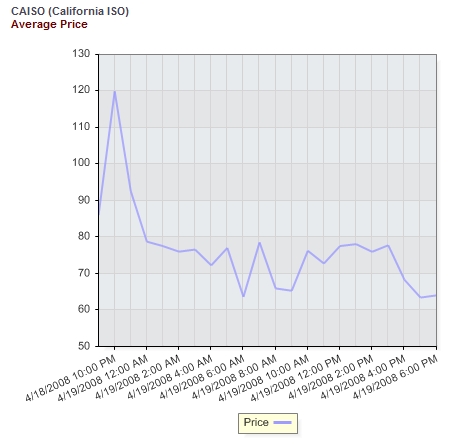

Province has 8,000 potential run-of-river power sites: B.C. Hydro study
COMMENT: When it comes to generating power on BC's streams, big numbers abound, bandied about by antagonists of the government's private power policies just as they are by gleeful greedy project proponents - dozens of rivers, hundreds of 'em, 500, 800. This report, claiming 8,242 sites in the province with hydroelectric potential, is about as useful as an inventory of grains of sand on BC's beaches.
This doesn't come easy, friends, but I'm almost ready to agree with Richard Neufeld on this one. Let's get real.
BC Hydro has electricity purchase agreements with about 60 small hydro projects. A large number of those will never get built - the attrition rate on EPAs since BC Hydro started its power calls a few years ago suggests it should improve its filtering for competence and capacity before wasting a lot of time and money on fanciful, but unviable, proposals.
The 60, though, represent a good proportion of the cherry picking. After that, the streams get less productive, more seasonal, more fish-bearing, more remote, further from load centres and transmission lines, more costly. Anybody talking about 800 sites is wasting your time - ain't gonna happen. 8,000 sites, and well, let's start counting sunbeams, and waves, and gusts of wind, too. The estimated cost of power produced at nearly 3000 of the sites KWL identified would be over $1000 MWh. And you thought BC Hydro's reference price of $88 was dear.
The full report is here.
And a map is here.
In conjunction with its 2008 Long Term Acquisition Plan, BC Hydro put together a set of resource option sessions with presentations and reports, including this one. There is info on biomass, coal, wind, and small & large hydro. It's all here:
http://www.bchydro.com/planning_regulatory/integrated_electricity_planning/2008_ltap.html
As a matter of interest, here's what they've been paying per megawatt hour for electricity on the spot market in California over the last 24 hours. It's a good time to be in British Columbia, with all our reservoirs full - selling hydroelectricity from our legacy infrastructure is very profitable at the moment. But if we're paying a marginal rate of $88/MWh, what happens to the netbacks?

By Stephen Hui
Georgia Straight
April 16, 2008
There are more than 8,000 sites in the province with the potential to be developed as run-of-river power projects, a study commissioned by B.C. Hydro and the B.C. Transmission Corporation has found.
All together, the 8,242 sites would have a potential installed capacity of more than 12,000 megawatts and could generate nearly 50,000 gigawatt hours of energy per year, the November 2007 report, prepared by Kerr Wood Leidal Associates Ltd., says.
The electricity from 121 of those potential sites would cost less than $100 per megawatt hour, the study found. There are 450 sites in British Columbia where the energy would cost $100 to $149 per megawatt hour, while 7,671 sites would produce power at a cost of more than $150 per megawatt hour.
“There is large potential for future development of run-of-river hydroelectric projects in BC,” the report concludes.
“The density of projects in BC relative to the density of the transmission / distribution and road network in BC, in addition to the large portion of the province that would be considered remote, indicates that clustered developments or construction of new transmission lines and road infrastructure could greatly improve the cost effectiveness of many projects.”
If all of the 121 sites with a potential energy cost of less than $100 per megawatt hour were to be developed, they would have a combined capacity of 1,388 megawatts, produce 6,113 gigawatt hours of power annually, and impact a total land area of 7,205 hectares (assuming 10-metre-wide corridors for roads, power lines, and penstocks, and excluding intakes and powerhouses). In total, these sites would have a dependable capacity of 60 megawatts and generate 4,925 gigawatt hours of firm energy.
Sixty of the 121 sites with a potential energy cost of less than $100 per megawatt hour lie in the Lower Mainland transmission region. Thirty-nine of the 121 sites would have an individual capacity of more than 10 megawatts.
In the legislature on April 15, New Democrat environment critic Shane Simpson cited the report and asked if Minister of Environment Barry Penner would support the Opposition’s call for a moratorium on private power projects until the government has studied their impacts and developed a provincial plan with consultation.
“If this doesn’t perpetuate a gold rush mentality, then I don’t know what does,” Simpson said, according to Hansard.
Responding to Simpson, Penner attacked the NDP’s record on energy but didn’t address the report.
But, following a question from NDP energy critic John Horgan, Minister of Energy Richard Neufeld did.
“I’m glad they dream in 8,200 numbers, but what they should get to is reality,” Neufeld told the legislature. “British Columbia needs 30,000 gigawatt hours of electricity within the next 20 to 25 years, with the anticipated growth. That’s not my number. That’s the B.C. Utilities Commission’s number and B.C. Hydro’s number.”
Responding to another question from Horgan, Neufeld said: “Always interesting to hear the NDP try to blow everything out of proportion. I guess 8,200 is the new number today. Maybe tomorrow it’ll be 10,000. I don’t know. Maybe the next day it’ll be a hundred. They don’t speak reality at any given point in time.”
B.C. Hydro and the B.C. Transmission Corporation hired Kerr Wood Leidal in August 2007 to assess the run-of-river potential of the province. The Burnaby-based engineering-services company used a geographic-information-system model to complete the resulting Run-of-River Hydroelectric Resource Assessment for British Columbia report and map.
Run-of-River Hydroelectric Resource Assessment for British Columbia (Kerr Wood Leidal) Report Map
Posted by Arthur Caldicott on 19 Apr 2008